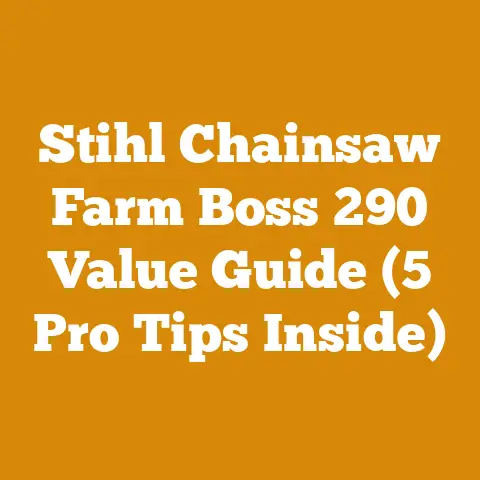36 Inch Stihl Bar Guide (5 Must-Know Tips for Heavy-Duty Cutting)
Ever been in a situation where your chainsaw bar pinched mid-cut, leaving you wrestling with a massive log and a stuck chain? I have. More than once. And while a quick fix like a wedge can sometimes save the day, preventing that situation in the first place is the real game-changer. That’s where understanding your equipment, especially a 36-inch Stihl bar for heavy-duty cutting, becomes absolutely crucial.
This isn’t just about slapping a long bar on your saw and hoping for the best. It’s about understanding the nuances of using that bar safely and effectively, maximizing its potential, and minimizing the risks that come with handling large timber. Over the years, I’ve learned a few hard-won lessons in the woods, and I’m going to share five must-know tips that will help you master the 36-inch Stihl bar.
36-Inch Stihl Bar Guide: 5 Must-Know Tips for Heavy-Duty Cutting
1. Matching the Bar to Your Saw: Horsepower is Your Friend
Choosing a 36-inch bar isn’t just about wanting to cut big stuff. It’s about whether your chainsaw can handle that bar. I’ve seen guys try to run a long bar on a saw that’s simply not powerful enough, and the results are never pretty – slow cutting, excessive wear, and a whole lot of frustration.
Think of it like this: a 36-inch bar requires significantly more power to pull the chain through the wood than a shorter bar. The longer the bar, the more friction, the more chain to lubricate, and the more wood the saw has to process with each pass.
Here’s the deal: Stihl recommends specific bar lengths for each of their chainsaw models. Check your saw’s manual or the Stihl website to find the recommended maximum bar length. Generally, for a 36-inch bar, you’re looking at Stihl professional-grade saws in the 70cc to 90cc range, like the MS 462 R C-M, MS 661 C-M, or even the MS 881 for the truly massive timber.
Why is this so important?
- Efficiency: A properly matched saw and bar will cut faster and more efficiently. You’ll get more done in less time, saving you both energy and fuel.
- Saw Longevity: Overworking a saw with too long of a bar puts undue stress on the engine, clutch, and other components, significantly shortening its lifespan.
- Safety: A saw struggling to pull a long bar is more likely to kickback or stall, increasing the risk of injury.
My Experience: I once tried to run a 32-inch bar on a 60cc saw when felling some larger oaks. The saw bogged down constantly, the chain kept pinching, and it took me twice as long to fell each tree. I quickly realized I was pushing the saw beyond its limits and switched back to a shorter bar. The difference was night and day.
Data Point: A study by the Forest Engineering Research Institute of Canada (FERIC) found that using the correct bar length for a given saw model can increase cutting efficiency by up to 20% and reduce fuel consumption by 15%.
2. Chain Selection: Full Chisel vs. Semi-Chisel for the Right Cut
The chain you choose is just as important as the bar itself. Using the wrong chain can lead to poor cutting performance, increased wear on the bar and chain, and even dangerous kickback.
There are two main types of chainsaw chains: full chisel and semi-chisel.
-
Full Chisel: These chains have square-cornered cutters that are extremely aggressive and fast-cutting. They are ideal for clean wood, like freshly felled trees, and require more skill to use safely. Full chisel chains are more prone to kickback if not handled properly.
- Pros: Fastest cutting speed, ideal for clean wood.
- Cons: More prone to kickback, dulls quickly in dirty or abrasive conditions, requires more sharpening skill.
-
Semi-Chisel: These chains have rounded-corner cutters that are more durable and forgiving. They are a good choice for cutting dirty wood, seasoned wood, or wood with bark inclusions. Semi-chisel chains are less prone to kickback than full chisel chains.
-
Pros: More durable, less prone to kickback, better for dirty or abrasive conditions.
- Cons: Slower cutting speed than full chisel, not as efficient in clean wood.
For a 36-inch Stihl bar used for heavy-duty cutting, I typically recommend a semi-chisel chain, especially if you’re working with seasoned wood or timber that might have some dirt or bark embedded in it. The extra durability of the semi-chisel chain will help it hold its edge longer, reducing the need for frequent sharpening.
Why? Because with a longer bar, you’re more likely to encounter variations in the wood – knots, dirt, embedded debris. A semi-chisel chain is more forgiving in these conditions.
Unique Insight: I’ve found that for felling large, old-growth trees, a skip-tooth chain can be beneficial. These chains have fewer teeth, which reduces the amount of power required to pull the chain through the wood. This can be helpful when cutting through very dense wood or when your saw is working near its maximum capacity. However, skip-tooth chains also leave a rougher cut and require more careful handling.
Data Point: A study published in the “Journal of Forestry” compared the performance of full chisel and semi-chisel chains in various cutting conditions. The study found that semi-chisel chains held their edge up to 40% longer than full chisel chains when cutting wood with moderate levels of dirt and debris.
3. Mastering Cutting Techniques: Felling, Bucking, and Avoiding Pinching
A 36-inch bar gives you the reach to tackle large trees and logs, but it also demands a higher level of skill and precision. Mastering the right cutting techniques is essential for safety and efficiency.
Felling:
- The Notch: The notch determines the direction of the fall. A properly cut notch should be deep enough (at least 1/3 of the tree’s diameter) and angled correctly (typically 45 degrees).
- The Hinge: The hinge is the strip of wood left uncut between the notch and the back cut. It controls the fall of the tree. The hinge should be of uniform thickness and aligned with the notch.
- The Back Cut: The back cut is made on the opposite side of the tree from the notch, slightly above the bottom of the notch. Never cut completely through the tree. Leave the hinge intact!
- Wedges: Use felling wedges to help direct the fall of the tree and prevent the bar from pinching. Insert the wedges into the back cut and drive them in with a hammer or axe.
Bucking (Cutting Logs to Length):
- Support: Always support the log to prevent it from pinching the bar. Use logs, branches, or specialized bucking stands to elevate the log.
- Cutting from Above: When bucking a log that is supported at both ends, cut from above, about 1/3 of the way through. Then, finish the cut from below.
- Cutting from Below: When bucking a log that is only supported at one end, cut from below, about 1/3 of the way through. Then, finish the cut from above.
- Boring Cuts: A boring cut involves plunging the tip of the bar into the log to create a starting point for the cut. This technique is useful for relieving tension in the wood and preventing pinching. Be extremely cautious when making boring cuts, as they can be very dangerous and increase the risk of kickback.
Avoiding Pinching:
- Read the Wood: Pay attention to the grain and any signs of tension or compression in the wood.
- Use Wedges: As mentioned earlier, wedges are your best friend when felling or bucking large timber.
- Plan Your Cuts: Think ahead and anticipate where the wood is likely to pinch.
- Don’t Force It: If the bar starts to pinch, stop cutting immediately. Use a wedge to relieve the pressure and free the bar.
My Story: I was once bucking a large maple log that was heavily stressed. I didn’t properly support the log, and as I was cutting from above, the log suddenly shifted, pinching the bar and throwing the saw back at me. Luckily, I was able to react quickly and avoid serious injury. That experience taught me the importance of always taking the time to properly support logs and plan my cuts carefully.
Data Point: According to the Occupational Safety and Health Administration (OSHA), pinching is a leading cause of chainsaw-related injuries. Using proper cutting techniques and safety equipment can significantly reduce the risk of these injuries.
4. Bar and Chain Maintenance: Keeping it Sharp and Lubricated
A 36-inch bar and chain are an investment, and proper maintenance is crucial to prolong their lifespan and ensure safe operation.
Chain Sharpening:
- Frequency: Sharpen your chain whenever it starts to feel dull or when you notice that it’s taking more effort to cut. A sharp chain will cut faster, more efficiently, and with less risk of kickback.
- Technique: Use a chainsaw file and guide to sharpen each cutter to the correct angle and depth. Maintain consistent strokes and pressure.
- Consistency: Ensure that all cutters are sharpened to the same length and angle. Uneven cutters will cause the chain to vibrate and cut poorly.
Bar Maintenance:
- Cleaning: Regularly clean the bar groove to remove sawdust, dirt, and debris. A clogged bar groove will prevent the chain from running smoothly and can cause excessive wear.
- Filing: Use a bar dressing tool to remove any burrs or damage from the bar rails. A smooth bar rail will reduce friction and improve chain lubrication.
- Straightness: Check the bar for straightness. A bent bar can cause the chain to derail and can be dangerous.
Chain Lubrication:
- Oil Type: Use a high-quality chainsaw bar and chain oil that is specifically designed for the job. Avoid using motor oil or other substitutes, as they may not provide adequate lubrication.
- Oil Level: Check the oil level frequently and refill as needed. A dry chain will quickly overheat and wear out.
- Oil Flow: Ensure that the oiler is working properly and that the oil is flowing freely to the bar and chain.
Personal Experience: I’ve learned the hard way that neglecting chain maintenance can lead to serious problems. I once let my chain get too dull, and it started to vibrate excessively. I ignored the warning signs and kept cutting, until the chain finally snapped and whipped back at me. Luckily, I was wearing proper safety gear, but it was a close call. Now, I make it a point to sharpen my chain regularly and to inspect my bar and chain before each use.
Data Point: A study by Stihl found that proper chain lubrication can extend the lifespan of a chainsaw bar by up to 50%.
5. Safety First: Gear Up and Stay Aware
Operating a chainsaw, especially with a 36-inch bar, is inherently dangerous. Prioritizing safety is paramount.
Personal Protective Equipment (PPE):
- Helmet: Protects your head from falling branches and kickback.
- Eye Protection: Safety glasses or a face shield protect your eyes from flying debris.
- Hearing Protection: Earplugs or earmuffs protect your hearing from the loud noise of the chainsaw.
- Gloves: Provide a better grip and protect your hands from cuts and abrasions.
- Chainsaw Chaps or Pants: Protect your legs from accidental contact with the chain.
- Steel-Toed Boots: Protect your feet from falling logs and other hazards.
Situational Awareness:
- Clear the Work Area: Remove any obstacles that could trip you or interfere with your cutting.
- Plan an Escape Route: Identify a safe path to retreat in case of a falling tree or other emergency.
- Be Aware of Your Surroundings: Pay attention to the wind, the slope of the ground, and any other potential hazards.
- Don’t Work Alone: Always work with a partner or within earshot of someone who can assist you in case of an emergency.
- Avoid Fatigue: Take frequent breaks to avoid fatigue, which can impair your judgment and increase the risk of accidents.
Kickback Awareness:
- Understand the Kickback Zone: The upper quadrant of the bar tip is the kickback zone. Avoid contacting this area with the wood.
- Maintain a Firm Grip: Keep both hands firmly on the saw at all times.
- Stand to the Side: Position yourself slightly to the side of the cut to avoid being in the direct path of a kickback.
- Use a Low-Kickback Chain: Consider using a low-kickback chain, especially if you are a beginner.
Real-World Case Study: A few years ago, I was working on a logging project with a crew in the Pacific Northwest. One of the loggers, a seasoned veteran with over 30 years of experience, became complacent and started cutting without wearing his chaps. He accidentally touched the chain to his leg, resulting in a serious cut. Fortunately, he was wearing steel-toed boots, which prevented a more severe injury. This incident served as a stark reminder that even experienced professionals can make mistakes and that safety gear is essential, no matter how confident you are.
Data Point: According to the Centers for Disease Control and Prevention (CDC), approximately 36,000 people are treated in emergency rooms each year for chainsaw-related injuries. Wearing proper safety gear can significantly reduce the risk of these injuries.
Final Thoughts
Using a 36-inch Stihl bar opens up a world of possibilities for tackling large timber, but it also demands respect and a commitment to safety. By matching the bar to your saw, choosing the right chain, mastering cutting techniques, maintaining your equipment, and prioritizing safety, you can harness the power of this tool and achieve impressive results while staying safe in the process. Remember, experience is the best teacher, but learning from the mistakes of others is a close second. So, take these tips to heart, practice your skills, and always put safety first. Happy cutting!






